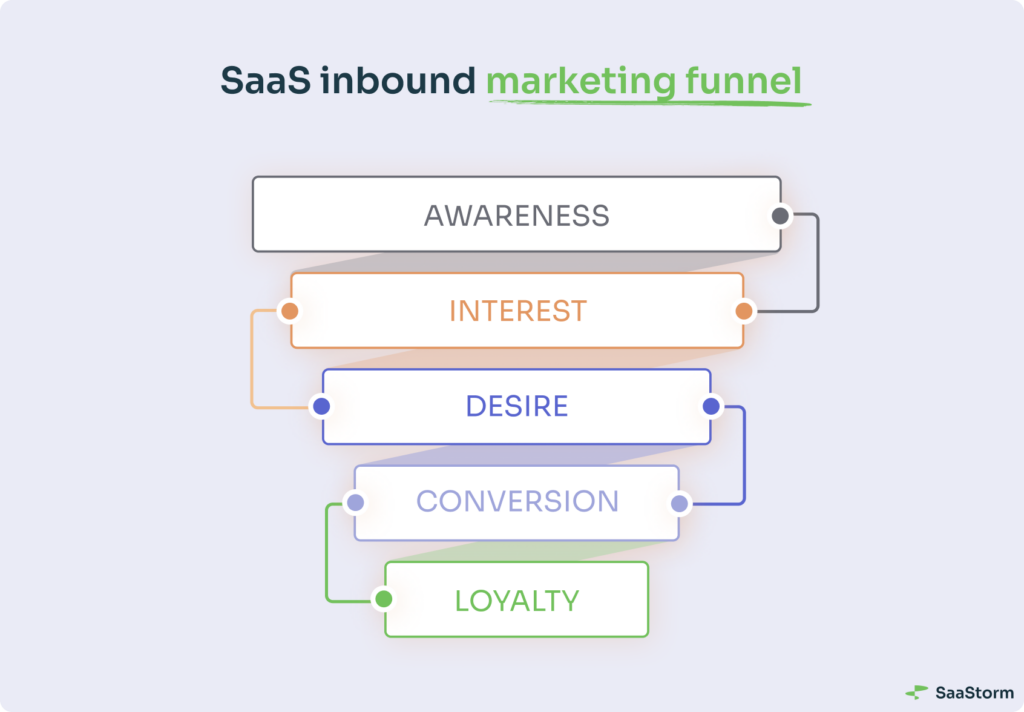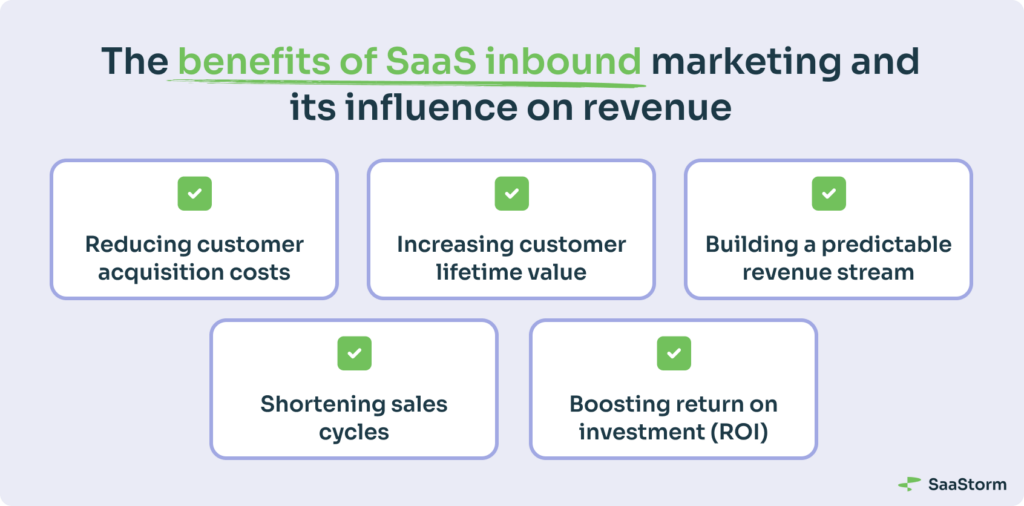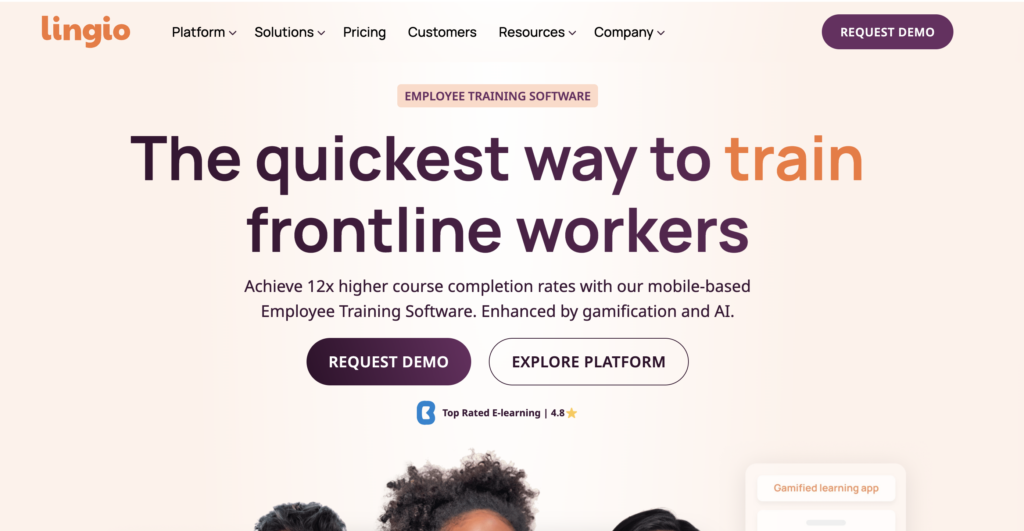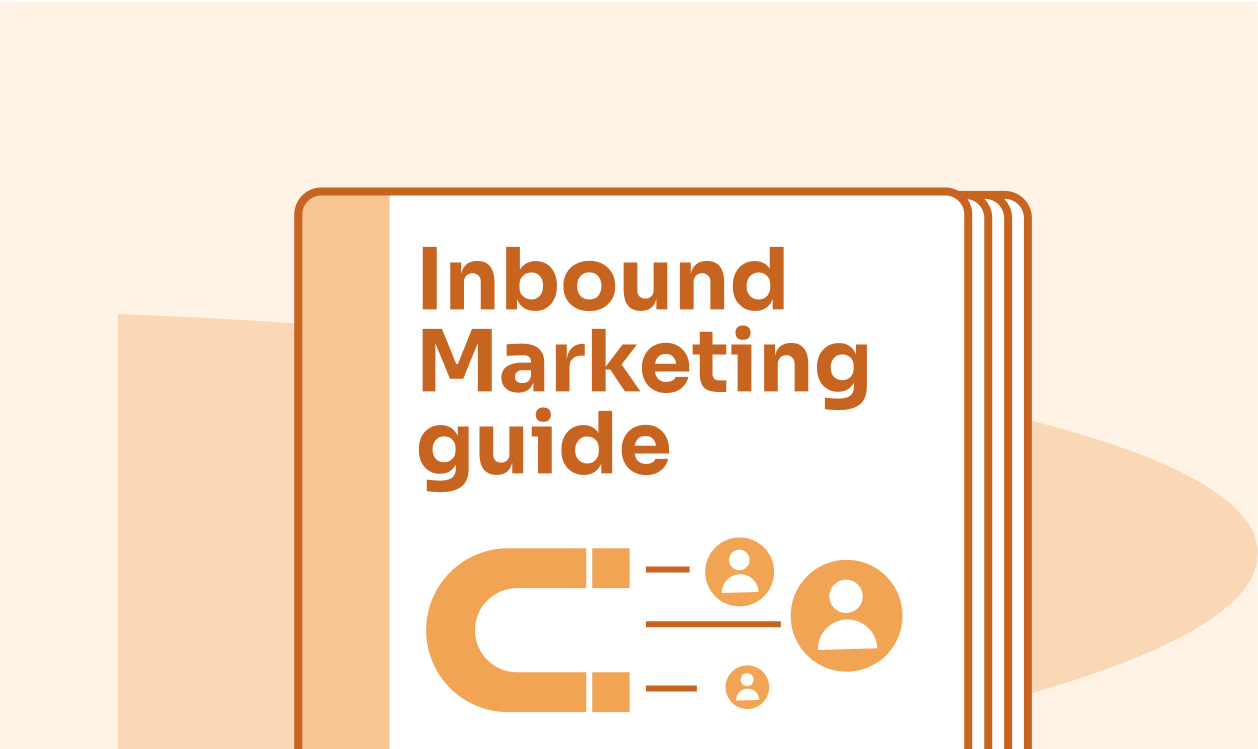You’ve been wasting money. Every day that passes without a SaaS inbound marketing strategy, you’re spending more to get fewer leads, missing out on the benefits of effective inbound marketing efforts. If your SaaS company is still relying on outbound tactics or just paid ads, you’re behind. The truth is, inbound marketing isn’t just a “nice-to-have” — it’s the key to sustainable growth.
To make sure you don’t get left behind, we’ve put together some great insights and strategies you can implement immediately.
Here’s what you’ll be able to do when you’re done reading:
- Build a content strategy that drives qualified leads.
- Master SEO with pillar pages and topic clusters.
- Automate lead nurturing to scale personalized outreach.
- Combine organic and paid tactics for full-funnel impact.
- Learn from SaaS giants like HubSpot and Dropbox to drive sustainable growth.
Let’s start with the basics…
The fundamentals of SaaS inbound marketing
Inbound marketing is all about pulling prospects toward your business instead of pushing your message out. For SaaS companies, it’s a smart way to guide your prospects through every stage of the inbound marketing buyer journey for SaaS without being intrusive.
In 2024, scaling and keeping your customer acquisition costs low is crucial. Working with a B2B SaaS marketing agency can help streamline this approach so you can focus on long-term lead generation and engagement.
What is SaaS inbound marketing?
Think of SaaS inbound marketing as a magnet. You’re using content, SEO, and digital channels to draw people in, not chase them. Instead of blasting ads, you’re solving the problems your audience cares about — naturally building trust and showing you’re the expert.
For B2B SaaS inbound marketing, this means creating targeted content that addresses the unique challenges of enterprise buyers.
It’s different from cold calls or paid ads, which are forms of outbound marketing. Inbound is about guiding prospects with valuable content, like case studies or demos, so they move through the buyer’s journey at their own pace.
Benefits of inbound marketing for SaaS companies
B2B inbound marketing for SaaS companies isn’t just about attracting leads—it’s about attracting the right leads. Here’s why it works so well for SaaS companies:
- It builds trust: When you’re consistently putting out helpful, relevant content, your audience starts seeing you as a trusted expert. That trust is what gets them to choose you over the competition.
- It lowers customer acquisition costs (CAC): Organic traffic, SEO, and content marketing are way more cost-effective than paid ads. That means you’re spending less to get new customers.
- It increases customer lifetime value (LTV): When you nurture leads with the right content, they’re more likely to stick around and engage with your product longer, increasing their LTV.
- It attracts qualified leads: People who find you through inbound marketing are already interested in what you offer. They’re actively looking for solutions, which means they’re more likely to convert.
Tracking and optimizing for conversions is crucial for inbound marketing success, ensuring that your efforts lead to measurable results.
But it’s crucial that you keep your buyer’s journey in mind.
Key stages of the SaaS inbound marketing funnel
Your inbound marketing strategy needs to meet potential customers where they are. The SaaS inbound funnel breaks down into four key stages: awareness, consideration, decision, and retention.
Each funnel stage requires a different inbound B2B SaaS marketing strategy to engage and convert prospects effectively. This ensures you’re providing the right content at the right time.
Let’s look at each.

Awareness stage
At the top of the funnel, it’s all about getting noticed. Inbound marketing and SEO work together to help SaaS companies attract the right audience by making sure their content is easily discoverable.
The goal? Create content that educates and starts building that all-important trust.
Consideration stage
Once you’ve got their attention, the focus shifts to nurturing those leads. Webinars, whitepapers, and comparison guides are perfect for showing why your solution is the best fit. Here, you’re helping them weigh their options and moving them closer to a decision.
Decision stage
Now, it’s time to convert those nurtured leads. This is where inbound marketing B2B strategies like case studies, product demos, and free trials do the heavy lifting. You’ve built the relationship—now you need to give them a reason to choose you.
Retention and advocacy stage
The journey doesn’t end with a sale. Retention is vital in SaaS, and happy customers turn into advocates. Keep them engaged with user education, loyalty programs, and upsell opportunities. The more value they get, the more likely they’ll recommend you to others.
A dedicated marketing team plays a crucial role in maintaining these relationships and ensuring ongoing customer satisfaction.
The benefits of SaaS inbound marketing and its influence on revenue
Inbound marketing doesn’t just generate leads—it directly impacts your bottom line. SEO inbound marketing efforts also help build a predictable revenue stream by consistently driving high-quality traffic that’s more likely to convert.

Let’s talk about how B2B SaaS demand generation via inbound marketing drives revenue growth for SaaS companies.
Reducing customer acquisition costs (CAC)
One of the biggest perks of inbound marketing is how it lowers your CAC. Organic traffic, content marketing, and SEO all require less investment than traditional paid ads. You’re creating long-term value with content that keeps pulling in leads over time, meaning your overall acquisition costs drop as you scale.
Increasing customer lifetime value (LTV)
The inbound marketing methodology helps keep customers engaged long after they’ve signed up. You build stronger relationships by offering continuous value through educational content and personalized communication.
When you get this right, you’ll see higher retention rates and more opportunities for upsells and cross-sells, boosting your LTV.
Building a predictable revenue stream
Consistent inbound efforts fill your funnel with high-quality leads, creating a more reliable revenue model. When you’ve got a steady flow of leads who are already interested in what you offer, your sales team can close deals faster, and your revenue becomes more predictable.
For example, SaaStorm helped Lingio achieve this by developing a tailored content engine and SEO strategy that led to a 500% increase in organic traffic and 11x growth in inbound leads in just nine months. This transformed Lingio’s inbound efforts into a sustainable source of high-quality leads and a core part of their revenue strategy.
Ready to see the same results? Let’s chat!
Schedule a CallShortening sales cycles
The right content, delivered at the right time, can move prospects through the funnel more quickly. When leads are educated and nurtured before they ever talk to sales, they’re already primed to buy. This shortens the time it takes to close deals, bringing in revenue faster.
Boosting return on investment (ROI)
Inbound marketing delivers compounding returns over time. Each piece of content you create continues to drive traffic and generate leads long after it’s published. By optimising your inbound strategy, you’ll see an improvement in marketing ROI, especially when you scale through automation and data-driven refinements.
18 Actionable SaaS inbound marketing strategies for 2024
Now that you know why inbound marketing is so powerful, let’s dive into the practical strategies you can start using right away. These tactics will help you attract more leads, nurture them, and ultimately convert them into loyal customers.
To capture more leads, it’s essential to leverage multiple inbound marketing channels like social media, email, and SEO, ensuring your brand reaches potential customers wherever they are.
1. Developing a comprehensive content strategy
Building a SaaS content strategy is the backbone of your inbound marketing. Start by creating a content plan with targeted SaaS content marketing examples. Ensure that it aligns with your buyer personas and business goals and resonates with your target audience.
Whether it’s blog posts, whitepapers, or videos, your content should address the pain points your audience faces. The key is consistency — stick to a schedule that keeps your content fresh and relevant.
2. Implementing pillar pages and topic clusters for SEO dominance
For inbound marketing search engine optimization, pillar pages and topic clusters are essential for building B2B SaaS SEO authority. A pillar page covers a broad topic in depth, while linked cluster content dives into specific subtopics. This is all part of in-depth keyword research and, when done right, helps you rank for multiple keywords and boosts your chances of getting found organically.
3. Leveraging marketing automation for personalized campaigns
Automation tools like HubSpot or Marketo allow you to automatically create drip campaigns that nurture leads. This approach can improve inbound marketing lead generation.
Here’s how to execute:
- Use behavioral triggers to send relevant content at critical touchpoints.
- Automate follow-up emails based on user actions like signing up for a demo.
- Segment your audience to deliver more personalized messages at scale.
4. Multi-channel engagement: Combining organic and paid strategies
A well-rounded inbound SaaS marketing approach combines organic and paid efforts. Here’s how you can balance both:
- Organic tactics: SEO, content marketing, and social media channels help you attract leads naturally.
- Paid strategies: PPC, LinkedIn ads, and retargeting ensure your brand stays visible to key audiences.
This multi-channel mix helps you reach prospects at various stages of their buyer journey.
We can help you with organic and paid. Let’s chat!
Schedule a Call5. Maximising ROI with email marketing campaigns
Email marketing remains one of the best ways to nurture leads. Focus on:
- Crafting personalized nurture sequences.
- Segmenting your audience for tailored messaging.
- Using behavioral data to time your emails perfectly.
The more targeted and relevant your emails, the better your chances of converting leads.
6. Crafting high-conversion landing pages and lead magnets
Effective landing pages and lead magnets are critical in inbound marketing for a SaaS company.
Landing pages are where conversions happen. Effective SaaS content writing focuses on clear, persuasive copy and strong CTAs to get prospects to take the next step.
Offer lead magnets like eBooks, checklists, or free trials to capture those valuable emails and start nurturing leads.
7. Video marketing for SaaS: Engaging and educating prospects
Video content is a must in 2024. It allows you to engage and educate your audience more dynamically. Types of video content that work well:
- Explainer videos: Showcase how your product solves specific problems.
- Product demos: Give prospects a walkthrough of your SaaS in action.
- Customer testimonials: Share success stories to build trust.
7. Webinars and virtual events: Building authority and engaging high-intent leads
Webinars and virtual events position you as a thought leader and engage high-intent leads. They’re interactive and give you a chance to answer questions in real time, building relationships with potential customers.
8. Building a social media presence: LinkedIn and beyond
LinkedIn is where B2B conversations happen, but don’t stop there. Depending on your audience, platforms like Twitter or YouTube might also be worth exploring. The goal is to engage your audience consistently and position your company as a valuable resource.
9. Influencer and partner marketing: Expanding reach through collaboration
Collaborating with industry influencers or partnering with complementary SaaS providers can help expand your brand’s reach. These partnerships give you access to new audiences and build credibility by association.
10. Account-based marketing (ABM) for targeted campaigns
ABM takes inbound to a more personalized level. By targeting key accounts with specific content and messaging, you can move high-value prospects through the funnel faster. Combining ABM with inbound marketing strategies gives you the best of both worlds—personalization and scalability.
Let’s set up your first ABM campaign together!
Schedule a Call11. Leveraging user-generated content (UGC) for authentic engagement
A great example of inbound marketing for SaaS is leveraging user-generated content.
UGC, like reviews, testimonials, and social media mentions, is gold for inbound. It’s authentic, it builds trust, and it’s free. Encourage your customers to share their experiences and leverage that content to attract new leads.
12. SEO best practices for SaaS in 2024
SEO in 2024 is about more than just keywords. Focus on:
- Optimising for voice search.
- Improving page load speeds.
- Creating high-quality, relevant content that aligns with search intent.
Optimising your content for search engines ensures that it is easily discoverable by your target audience, driving more qualified traffic to your website.
Delivering value is the key to SEO success, not just ranking for terms.
13. Utilising data and insights to refine strategies
Data is your best friend in inbound. Use tools like Google Analytics, your CRM, and heatmaps to understand what’s working and what’s not.
By analysing which types of content are performing best, SaaS companies like yours can continuously optimise their inbound marketing process to meet customer needs and improve results
14. Conversion rate optimisation (CRO) techniques for SaaS websites
CRO helps you convert more visitors into leads. Focus on:
- A/B testing headlines, CTAs, and layouts.
- Simplifying forms to reduce friction.
- Ensuring your website is mobile-friendly.
The goal is to get the most out of the traffic you’re already getting.
15. Content syndication and partnerships for extended reach
Syndicating your content on third-party platforms or partnering with industry publications can help you reach a broader audience. The more places your content appears, the higher your chances of attracting new leads.
16. Integrating chatbots and AI tools for lead engagement
Chatbots and AI tools can engage leads in real time, answering their questions and guiding them toward the next step. This instant interaction is especially valuable for SaaS, where prospects might need quick answers before committing to a demo or trial.
17. Creating an integrated campaign strategy for maximum impact
Inbound works best when it’s part of an integrated strategy. Tie together your content, SEO, social media, and email marketing for a cohesive approach that guides leads smoothly through the funnel.
18. Continuous A/B testing and optimisation for campaign success
Always be testing. A/B testing your campaigns — whether it’s emails, landing pages, or CTAs — helps you identify what’s working and where to make improvements. Minor tweaks can lead to significant results.
Section recap
We know that’s a lot to take in, so here’s a quick recap of the 18 key strategies:
- Develop a content strategy: Align your content with buyer personas and stay consistent.
- Implement pillar pages and topic clusters: Build SEO authority by organising content effectively.
- Leverage marketing automation: Personalise campaigns at scale with tools like HubSpot.
- Balance organic and paid strategies: Use a mix of SEO, SaaS content marketing, and PPC for maximum reach.
- Maximise ROI with email marketing: Create targeted nurture sequences that hit the right inbox at the right time.
- Craft high-conversion landing pages: Use clear copy and strong CTAs to drive conversions.
- Use video marketing: Engage prospects with explainer videos, demos, and testimonials.
- Host webinars and virtual events: Build authority and connect with high-intent leads.
- Expand reach with influencers and partnerships: Collaborate with industry leaders for increased credibility.
- Integrate ABM: Personalise content for key accounts to fast-track conversions.
- Utilise UGC: Leverage customer reviews and testimonials to build trust.
- Stay on top of SEO best practices: Focus on voice search, page speed, and valuable content.
- Use data to refine strategies: Continuously optimise based on performance insights.
- Focus on CRO: A/B test, simplify and optimise your website for better conversions.
- Syndicate content and partner up: Get your content in front of more eyes.
- Engage leads with chatbots and AI: Offer real-time support to prospects.
- Create integrated campaigns: Align your efforts across multiple channels for maximum impact.
- Always A/B test: Keep tweaking and improving every aspect of your strategy.
Pro tip for B2B SaaS: Focus on quality over quantity. A well-placed piece of content or an automated drip campaign can do more than a barrage of ads ever could. Keep refining and adjusting based on what works for your audience.
Case Studies: Successful SaaS Inbound Marketing Campaigns
Enough with the theory. Let’s take a look at what SaaS marketing success…
Case Study 1: HubSpot – Driving ARR with Inbound Marketing

Challenge
HubSpot needed to scale its SaaS business while driving down customer acquisition costs and positioning itself as a leader in marketing software.
Key Strategies:
- Content marketing: HubSpot created a massive library of content, including blogs, e-books, and guides that focused on solving common marketing pain points for its audience.
- SEO and thought leadership: They optimised their content to rank highly for industry-relevant keywords, driving millions of organic visitors each month.
- Call-to-actions (CTAs): Every piece of content included tailored CTAs that aligned with the reader’s search intent, increasing lead generation through targeted offers.
- Lead generation tools: HubSpot created the Website Grader, a free tool that helped users evaluate their websites. This tool alone captured millions of leads over time.
Results:
- HubSpot scaled to over $1 billion in ARR, largely due to the consistent flow of inbound leads.
- Their organic search visibility became nearly unbeatable, with the bulk of traffic coming from non-paid channels.
Takeaway: HubSpot’s success proves the value of investing heavily in content and SEO. By consistently providing value through educational resources, they built long-term trust and a steady stream of high-quality leads.
Case Study 2: Dropbox – Scaling Through the Freemium Model

Challenge
Dropbox needed to quickly grow its user base while keeping acquisition costs low.
Key Strategies:
- Freemium model: Dropbox allowed users to start with a free account, offering limited storage. As users’ needs grew, many opted for paid plans with additional features.
- Referral program: Dropbox’s famous referral program rewarded users with extra storage for inviting others to the platform. This created a viral loop where each user effectively became a marketer for the product.
- Onboarding process: Dropbox made it incredibly easy to sign up and start using the product, removing barriers to entry.
Results:
- Dropbox grew to over 700 million registered users, with a significant portion upgrading to paid plans.
- By 2020, Dropbox had generated $1.9 billion in revenue, proving the success of the freemium model.
Takeaway: Combining a freemium model and an incentivised referral program helped Dropbox grow rapidly. By keeping entry barriers low, they maximised user adoption and encouraged organic growth.
Case Study 3: Calendly – Built-In Virality

Challenge
Calendly wanted to reduce customer acquisition costs while maintaining rapid growth in a crowded SaaS market.
Key Strategies:
- Built-in virality: Calendly’s scheduling feature automatically encouraged sharing. When users sent out their scheduling links, they promoted the tool to new users without needing a paid acquisition strategy.
- Simplicity: The product’s design was intuitive and easy to use, encouraging quick adoption by both free and paid users.
- Freemium plan: Similar to Dropbox, Calendly offered a free version of the tool with paid upgrades for advanced features like integrations and customisation.
Results:
- Calendly grew its ARR significantly without heavy reliance on paid advertising, keeping acquisition costs low.
- The built-in viral loop continued to drive organic growth as each user introduced new prospects to the product.
Takeaway: Calendly’s focus on simplicity and virality allowed it to grow rapidly without substantial marketing budgets. Building sharing and referrals directly into your product can reduce acquisition costs while driving scalable growth.
Case Study 4: How SaaStorm transformed Lingio’s inbound in 9 months

Challenge
Lingio, a B2B SaaS company specialising in AI-powered training solutions, wanted to shift from an outbound-heavy strategy to a robust inbound approach.
With an empty blog and minimal online presence, they struggled with visibility—averaging only 45 daily clicks and 400 impressions on Google Search. Lingio needed a scalable inbound strategy to attract consistent, high-quality traffic and generate leads.
Key Strategies:
#1 Discovery phase: We conducted a 2-week deep dive to map out Lingio’s competitive landscape and uncover growth opportunities, resulting in:
- Competitor gap analysis
- Topic cluster mapping
- 20+ content ideas and linking strategies
- A detailed 3-month marketing plan
#2 Content engine setup: Built a dual-content production approach using a blend of AI-assisted articles and human-generated pieces for budget efficiency, ensuring consistent output of high-quality content.
#3 Topic clusters and pillar pages: Established Lingio as an authority with strategic topic clusters and SEO-optimised pillar pages.
#4 SEO and link-building: Developed an external linking strategy, securing 30+ high DR backlinks to increase Lingio’s domain authority and search rankings.
#5 Ongoing optimization: Conducted regular audits, updated internal linking, and refreshed content for sustained SEO performance.
Results:
- 500% growth in organic traffic: Fivefold increase in traffic, turning Lingio’s blog into a top lead generator.
- 11x increase in inbound leads: Targeted content efforts resulted in 11 times more inbound leads, fueling the sales pipeline.
- 200+ MQLs: Generated over 200 marketing-qualified leads through organic search, powering 60% of Lingio’s sales pipeline.
Takeaway: SaaStorm’s strategic approach, combining content production, SEO, and continuous optimisation, transformed Lingio’s inbound marketing. From an empty blog to a lead-generation engine, Lingio’s inbound success demonstrates the power of a well-executed, data-driven strategy.
Over to you: Implementing your SaaS inbound marketing strategy
Inbound marketing isn’t a quick win; it’s a game-changer for sustainable growth. By zeroing in on content, SEO, multi-channel engagement, and personalisation, you’re setting up your SaaS for success that scales. Each of these strategies isn’t just about attracting leads—it’s about creating a steady flow of the right leads who will convert and stick around.
Ready to put this into action? Here’s your quick checklist for building a winning inbound strategy:
- Define your audience: Get crystal clear on your buyer personas.
- Map the funnel stages: Know your touchpoints from awareness to advocacy.
- Develop quality content: Create value-driven resources that solve your audience’s pain points.
- Optimise with SEO: Use pillar pages and clusters to dominate search results.
- Engage across channels: Combine organic and paid strategies for full-funnel impact.
- Automate smartly: Set up automated workflows to personalise outreach at scale.
Sometimes, it feels less overwhelming with a partner at your side. SaaStorm can help you design a full inbound marketing strategy, including B2B SaaS content writing services. Let us help you connect and build trust with your audience to ensure your SaaS growth!
Need a quick overview? We have you covered with these FAQs!
Frequently Asked Questions
It attracts high-quality leads, reduces acquisition costs, and builds trust—key for SaaS growth.
Inbound pulls prospects in through valuable content, while outbound pushes messages out via ads or cold outreach.
Content educates and nurtures leads, guiding them through the buyer journey and positioning you as a trusted resource.
Yes! Combining inbound’s organic reach with targeted outbound tactics creates a balanced lead generation approach.
Inbound is a long-term strategy; expect to see traction within a few months as content and SEO build momentum.



 SaaStorm experts in your inbox.
SaaStorm experts in your inbox.


